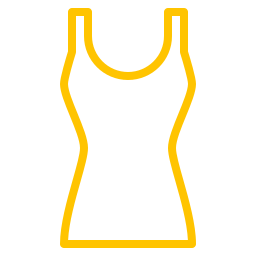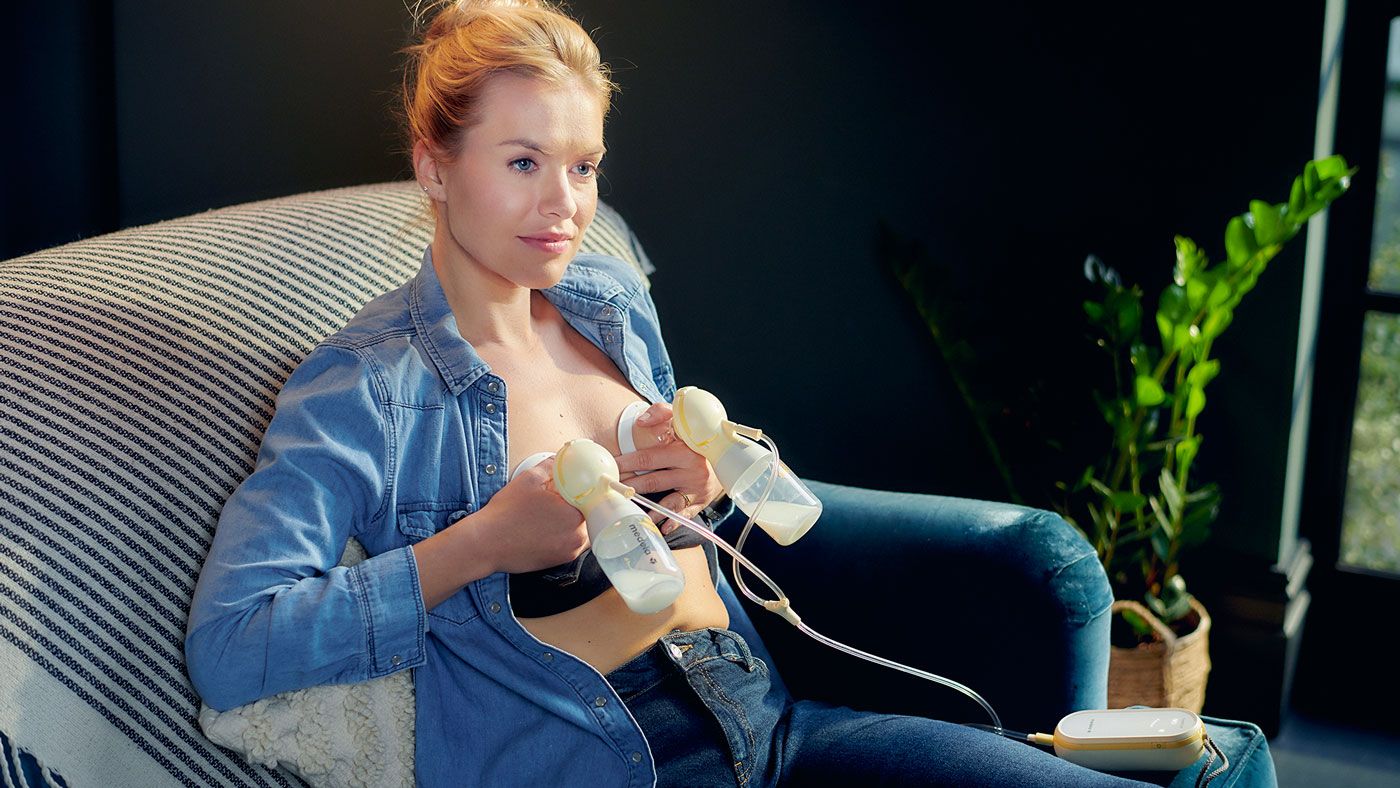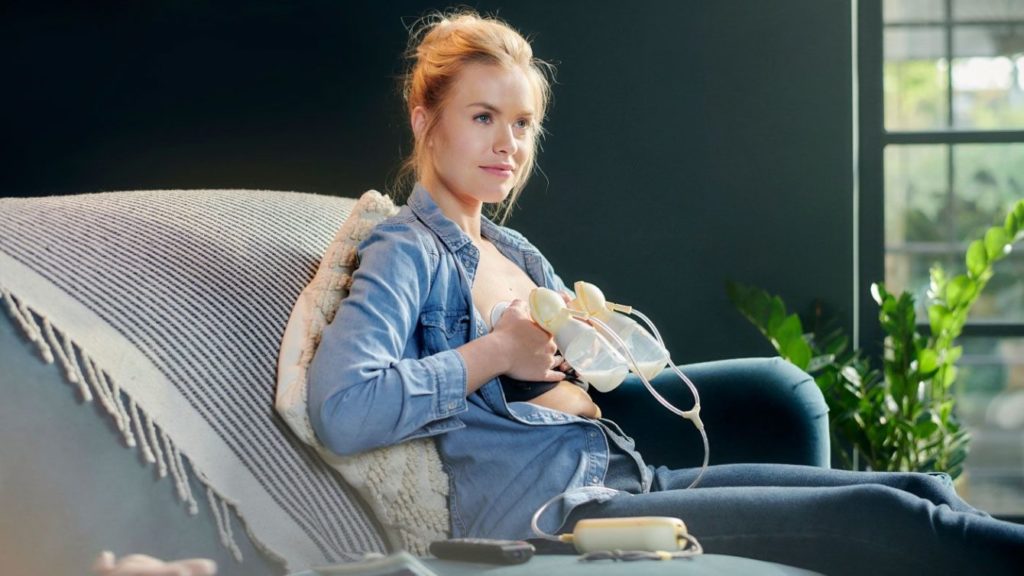With such a wide range on the market, deciding which breast pump to choose can be daunting. Don’t worry – whether you express occasionally or every day, our guide on how to pick a breast pump will help you find one that’s right for you and your baby.
When you’re pregnant picking a breast pump might not be on top of your to-do list. And that’s perfectly fine, as Nania Schärer-Hernández, Director of the Global Education Department at Medela, explains: “While you’ll probably buy a lot of baby equipment and accessories before your baby’s birth, when it comes to choosing a breast pump it can pay to wait a bit.”
“Of course, being prepared is important and it’s a good idea to familiarise yourself with different breast pumps in advance – but it’s only once your baby is here and you know what your breastfeeding situation is that you’ll really know your requirements.”
Every mum and baby has different needs, and these needs can change along the course of your breastfeeding and expressing journey. So let’s start by taking a look at the range of breast pumps on offer, and then delve deeper into which pump suits which situation.
Which type of breast pump should I choose?
As far as breast pump technology is concerned, you have three main choices. Understanding these will help you when you’re deciding what you want from a breast pump.
- A manual or electric pump?
Manual breast pumps are cheaper than electric models, quiet and handy for occasional expressing. But they can be hard work if used frequently, as you have to keep pumping the handle to create the vacuum. Electric breast pumps are easier and more convenient to use, as the motor does the pumping for you.2-Phase Expression technology mimics a baby’s natural sucking behaviour. “At the start of each breastfeed, your baby uses short, fast sucks to stimulate your let-down reflex. Once the milk begins to flow, he changes to slower, stronger sucking that takes in as much milk as possible,”1 Nania explains. “Medela developed 2-Phase Expression technology to replicate this feeding pattern and create an effective and more natural way to express.”2,3Conveniently, all Medela electric breast pumps can also be battery operated, either with a rechargeable battery pack or standard AA batteries. - A single or double breast pump?
A single electric breast pump is ideal for expressing from time to time. A double breast pump (which draws milk from both your breasts simultaneously) is more convenient for expressing regularly – whether for medical reasons or because you’ve returned to work.As well as halving the amount of time you spend expressing, a double breast pump delivers 18% more milk on average than pumping from each breast in turn. This makes it a great choice for busy mums. And the milk you obtain when double pumping has a higher fat and calorie content too.4 - Why to rent a Medela Symphony hospital-grade breast pump?
If you’re expressing frequently each day or relying on a breast pump to initiate and build your milk supply, keep in mind that Medela’s Symphony hospital-grade breast pump can be rented for however long you need it. Symphony has unique research-based suction patterns that have been clinically tested to initiate, build and maintain milk production and it’s especially advisable to use this if you’re pumping in the first five days after your baby’s birth.5 So check if there is a rental station near you.
Why choose a Medela breast pump?
“At Medela we believe you get the best results by imitating nature as closely as possible,” explains Nania. “We have an impressive track record of investment in science and research partnerships that have made important new discoveries about the anatomy of the breast and the science of lactation.
“Understanding how nature works helps us make better products to support mums and babies,” she continues. “That’s why our electric breast pumps have 2-Phase Expression technology and why our hospital-grade double breast pumps have an initiation program that mimics the way a newborn feeds.”6
Choosing a pump that suits your needs and lifestyle
Which is the right breast pump for you depends on how often you expect to be pumping, and where you are in your lactation journey.5 This journey is divided into three stages:
- Initiate – the first five days
- Build – days six to 30
- Maintain – beyond 30 days
Picking a suitable breast pump depends on which stage you’re at, as well as your personal circumstances, your baby’s needs, and your attitude to breastfeeding and expressing. Take a look at the scenarios below and see which one applies to you.
My baby can’t feed from the breast, so I need to express every feed
Some babies can’t breastfeed because they find it difficult to latch or suck, perhaps because they were born prematurely, have special needs, or are poorly. Some mothers and their newborns have to be separated for medical treatment. And some mums want their baby to have the benefits of breast milk but don’t feel able to breastfeed.
“The key to producing sufficient breast milk in any of these situations is to start using a Symphony hospital-grade double electric breast pump with initiation technology within hours of the birth,” says Nania.
Product recommendation
The Medela Symphony double electric breast pump’s unique initiation program mimics a newborn’s feeding pattern during the first few days of breastfeeding, with rapid sucks and longer pauses. Evidence suggests these infant sucking patterns stimulate a mother’s breasts for optimal milk production.7 “Starting with the initiation program has been shown to deliver significantly more milk over the first 14 days compared to starting with the standard program.”5,6 Nania explains.
As well as being the breast pump of choice for a great many hospitals and birthing units, Medela Symphony pumps can also be rented for home use. So when you get home you can use the same pumping technology your body is already used to, and the same pumping accessories too. Find out how to rent a Symphony on our website.
“Definitely get a good double pump, and a hands-free pumping bra too,” says Catherine, mum of two, New Zealand. “My son’s nurse explained that if you pump exclusively you need a hospital-grade double pump to give your breasts a similar level of stimulation to a hungry baby.”
I’m having trouble initiating my milk supply
It’s not unusual for babies to have latching difficulties, or for mums to have concerns about their breast milk supply, in the early days of breastfeeding. “If you and your newborn are struggling to get breastfeeding initiated, seek help from a lactation consultant or breastfeeding specialist as soon as possible – expert advice on latching and positioning often helps,” says Nania.
If you’re still in hospital, or your baby is in the first few days of life, use a Medela hospital-grade breast pump with an initiate program. This will allow you to initiate and build your breast milk supply and feed your baby expressed milk.
You might need to express for a few days or weeks while your baby and your body get the hang of breastfeeding. Using a double breast pump will enable you to maximise the amount of expressed milk you can obtain in the least amount of time, and the milk will be higher in calories too.4
Product recommendation
Because you probably won’t need to pump full-time in the long term, consider renting a Medela Symphony hospital-grade breast pump – the only hospital-grade breast pump with research-based initiation technology – for a month or two.
“The Medela double breast pump was amazing. The midwife encouraged me to use it as often as I could to get my supply up for my twins, which I did,” says Anna, mum of two, UK.
If you don’t need the initiation program and you prefer to have your own breast pump, or want a portable option, choose an efficient double electric breast pump, such as the Medela Freestyle, which has a long-lasting rechargeable battery. Alternatively, check out the Medela Swing Maxi double electric breast pump.
I’m exclusively breastfeeding and want to pump occasionally
If you’ve established breastfeeding and now want to express milk from time to time – perhaps for your partner or a caregiver to feed to your baby while you go out – then a manual breast pump or single electric breast pump should be fine.
Product recommendation
Choose between the Medela Harmony manual breast pump or Medela Swing single electric breast pump.
“I used the Medela Swing single electric pump to help relieve mastitis with my first child, and so my second could have my breast milk while he was in childcare. It was one of the few brands that fitted comfortably over my nipples,” says Victoria, mum of two, Australia. “It was perfect because it was fast and quiet, triggered my let down quickly, and could run on batteries if I couldn’t get to an electrical socket.”
I’m returning to work and want my baby to have expressed milk
As a breastfeeding working mum, you’re likely to be expressing every day for several months, and you may want to take your breast pump to and from work.
Product recommendation
A lightweight portable breast pump is ideal, and a double electric model, such as the Medela Swing Maxi or Medela Freestyle, will enable you to collect more milk in less time, making it perfect for quick pumping breaks.
“I was still breastfeeding when I went back to work, but my boss was very supportive and gave me breaks when I needed to pump milk. I used the Medela Swing Maxi – I even pumped on the tram on the way to work!” recalls Sarah, mum of two, Australia.
Hopefully you now feel a little more clued-up about what type of pump is right for you. “Remember that expressing effectively isn’t only a matter of which breast pump you have. How and when you use your breast pump can make a big difference to the quantity of milk you collect. And correctly fitting breast shields are a must,” says Nania.
Next, read our top breast pumping tips.
- Mizuno K, Ueda A. Changes in sucking performance from nonnutritive sucking to nutritive sucking during breast- and bottle-feeding. Pediatr Res. 2006;59(5):728-731.
- Kent JC et al. Response of breasts to different stimulation patterns of an electric breast pump. J Hum Lact. 2003;19(2):179-186.
- Mitoulas LR et al. Effect of vacuum profile on breast milk expression using an electric breast pump. J Hum Lact. 2002;18(4):353-360.
- Prime DK et al. Simultaneous breast expression in breastfeeding women is more efficacious than sequential breast expression. Breastfeed Med. 2012;7(6):442-447.
- Meier PP et al. Which breast pump for which mother: an evidence-based approach to individualizing breast pump technology. J Perinatol 2016;36(7):493-499.
- Meier PP et al. Breast pump suction patterns that mimic the human infant during breastfeeding. J Perinatol. 2012;32(2):103-110.
- Sakalidis VS et al. Ultrasound imaging of infant sucking dynamics during the establishment of lactation. J Hum Lact 2013;29(2):205-213.






















